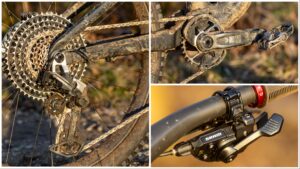Trek's shapeshifting 29er trail bike is packed with adjustability, but do the numbers add up?
Trek Fuel EX 9.7 XT Gen 6 review
Hot on the heels of the Trek Fuel EXe, the new Fuel EX shares a similar silhouette, albeit without the compact TQ motor and 360Wh battery. And just like the EXe, the EX is available with an aluminium or full carbon frame, where both options sport integrated down tube storage. It’s certainly a cutting-edge, with all mod-cons, but where does it stack up against the best full-suspension bikes on sale right now?

Trek Fuel EX 9.7 boasts chiselled good looks and a pin-sharp ride
Unlike the Specialized Stumpjumper Evo Elite Alloy that’s also in this head to head test, Trek doesn’t currently offer a high-end alloy build on the Fuel EX in the UK, so we went with the Gen 6 Fuel EX 9.7 XT, which is the entry-level carbon bike. With the more expensive carbon frame, the build kit clearly isn’t as bling as on the Specialized, which we’ll get to in just a minute.

The Gen 6 Trek Fuel Ex 9.7 offers a fun, poppy and playful ride
Frame and geometry
First, let’s take a closer look at the frame. To bring the analogue bike inline with Trek’s mid-powered e-bike, frame travel has been bumped up to 140mm and when paired with the 150mm Fox Rhythm fork, the new EX is the most capable Fuel to date.

Shimano drivetrain mixes 12-speed XT and SLX for a smooth, light shift action
And it’s not just the travel that’s been increased. The reach numbers have grown across all six frame sizes, and the head tube now accepts offset headset cups that offer +/-1º of head angle adjustment. Unfortunately, the cups are not supplied with the bike, and they have to be pressed into the frame, so head angle is not something you can really play around with trailside like on the Stumpy Evo.

Aftermarket headset cups offer +/- 1º of head angle adjustment
Well, at least not with the headset cups. And that’s because the EX also sports Mino link flip chips in the suspension rocker link. In the low setting they give the EX a 64.4º head angle and a 338mm BB height. Flipping the Mino Link to the high position steepens the head angle by 0.5º and raises the BB height by 8mm. Taken together with the aftermarket headset cups, that gives you six unique geometry settings, just like on the Stumpy Evo.

Trek’s Mino Link flip chips in the seatstays offer BB hight and head angle adjustment
And while Trek does not offer chainstay length adjustment, the Fuel EX does have size specific chainstay lengths: XS and S share 430mm chainstays, then you get 5mm jumps as you go up the size range: 435mm on the M, 440mm on M/L, 445mm on L and 450mm on the XL.

No chainstay length adjustment here, but the Fuel EX has size-specific rear ends
Trek has another adjustment up its sleeve though. By introducing a second set of Mino Links, this time in the lower shock mount, it offers riders two distinct progression rates for the suspension linkage. But why bother? Well, coil shocks and air shocks have different spring curves, so the progression rate of the suspension linkage on the Trek Fuel EX can now be tailor more precisely for both shock options. It’s handy too for riders that simply want more bottom out resistance from the stock Fox Float X air shock without having to crack open the air can to add volume spacers.

Coil or air? Flip chips in the lower shock mount offer two distinct suspension progression rates.
Suspension
Even though the Fox 36 Rhythm fork doesn’t get the self-aligning 15mm axle and lubrication channels found on the 36 Factory fork lowers, it’s still incredibly supple off the top. The district lack of initial friction and the free flowing oil in the Grip1 damper makes the 150mm Rhythm fork great at gobbling up trail chatter, even at higher speeds. The trade off then, is that it doesn’t offer the same degree of mid-stroke support, or adjustment as the Grip2 equipped fork on the Specialized. This means the rider has to work harder to offset the dynamic swings in geometry to stay centred on the bike. It’s why we ended up at a spring pressure on the guide chart for a 10kg heavier rider, just to get more support.

Trek signature ABP suspension boasts 140mm travel and is married to a 150mm Fox 36 fork
And it’s a similar story with the rear suspension. Running less sag on the Fox Float X Performance shock not only made the Fuel EX climb better, it also offered more support for fast corners and drops. Yes, you trade some of that pitter patter comfort, but the firmer suspension settings front and rear definitely make it easier to ride the Fuel EX faster, up or down.

The Fox 36 Rhythm fork has 150mm travel and gets the basic, but supple, Grip1 damper
Components
Trek has missed a trick by not adding some extra tools to the removable rear axle lever on the EX. In addition to the 6mm hex key, Scott has managed to fit a 5mm and a T25 to a similar tool on the Genius. This was brought to our attention, because we struggled to get the Shimano SLX shifter to marry perfectly with the SRAM DB8 brakes and we needed a T25 to move the brake lever. In the end we ran the shifter pod inboard of the brake, just to get out of the way.
The SRAM DB8 front brake also presented with a variable bite point, but it was nothing a quick bleed couldn’t fix. It’s worth noting though, that the DB8 brakes use mineral oil, not DOT brake fluid like all of the other SRAM brakes. Once sorted, the DB8 brakes offer better and more consistent stopping power, with a lighter lever feel than the Code RS units on the Stumpy Evo.

SRAM’s DB8 brakes offer a light, smooth lever action, that backed up with ample stopping power from the 4-piston calliper
Get on the gas and freehub engagement with Line Comp 30 wheels is rapid, but there’s still a fair bit of clatter from the Shimano drivetrain when the trails get rougher. And it’s not the chain hitting the frame, it’s more like freehub clatter. The stock Bontrager XR5 Team issue tyres also make themselves vocal, as then tend to pop and ping of rocks and roots too readily for our linking.
Performance
Even though the Trek Fuel EX has similar geometry and is actually longer in reach measurement than the Specialized Stumpy Evo, it rides like a smaller bike. And that’s simply because you have to shift your weight around more to maintain a balanced weight distribution between the contact patches of the tyres. We chalked this up to the suspension response of the Fox 36 Rhythm fork not offering enough support.

With more travel and adjustability, the Trek Fuel Ex 9.7 has never been more capable
It’s almost as if the fork puts an artificial speed limiter on the Trek, even though it absorbs bumps really well. Much in the same way as soft suspension on a car makes it harder to drive fast. With a better fork, we’re pretty confident that the Fuel EX could be pushed so much harder. In fact the firmest suspension set up always felt best.

Trek Fuel Ex 9.7 Gen 6
We even flipped the shock Mino Link to the more progressive setting, and while the O-ring on the shock body (the shaft is hidden under the air can) ended up in the exact same spot on every test run, the bike feet a little harsher on big hits, but altogether more stable.
So the fork is smooth and plush, and the Fuel EX still makes for a fun and engaging ride. It’s poppy and playful, and while the sharp clean lines of the carbon frame catch the light perfectly, the square tube profiles on the EX seem to snag your knees and calf muscles more than normal, especially when pulling shapes in the air or getting sideways in a corner. Knee pads are recommended at all times then.

Sharp lines make the Trek Fuel Ex 9.7 carbon frame eye-catching, but you can catch you legs on them too
Also we were under the impression that carbon doesn’t really like square edges, so you could argue that the design is more about aesthetics than outright performance or weight saving. The bottom line is that Trek needs to offer the alloy Fuel EX with a higher level build kit, especially the suspension components, instead of stopping short and simply using the carbon frame as the next step up in the performance ladder.
Verdict
Carbon frames are cool and all, and the weight savings are not to be sniffed at. But if you’re on a tighter budget, your money is better spent elsewhere. Ideally on a trail bike with an alloy frame and high-end suspension components. Trek doesn’t currently offer the alloy Fuel EX platform with 4-way adjustable damping, so a better fork is what’s needed to unlock the Trek Fuel EX 9.7 XT's full potential. More adjustability isn’t for everyone though, but even with the recommended baseline settings the Specialized Stumpy Evo Elite Alloy always instilled more confidence and allowed us to ride faster in every situation. It’s not that the Trek was a slow bike, it simply wasn’t as fast.















